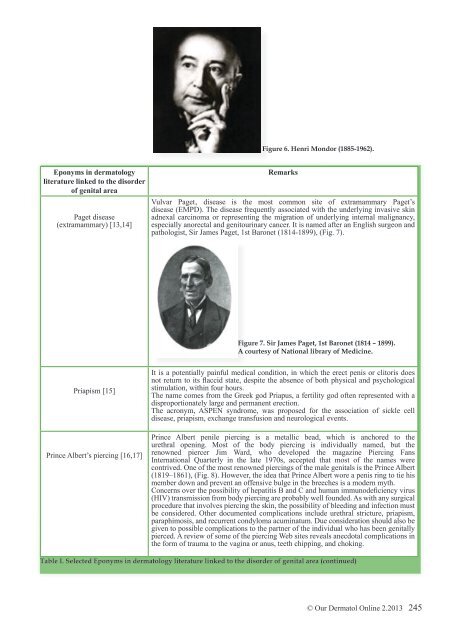download full issue - Our Dermatology Online Journal
download full issue - Our Dermatology Online Journal
download full issue - Our Dermatology Online Journal
Create successful ePaper yourself
Turn your PDF publications into a flip-book with our unique Google optimized e-Paper software.
Figure 6. Henri Mondor (1885-1962).<br />
Eponyms in dermatology<br />
literature linked to the disorder<br />
of genital area<br />
Paget disease<br />
(extramammary) [13,14]<br />
Remarks<br />
Vulvar Paget‚ disease is the most common site of extramammary Paget’s<br />
disease (EMPD). The disease frequently associated with the underlying invasive skin<br />
adnexal carcinoma or representing the migration of underlying internal malignancy,<br />
especially anorectal and genitourinary cancer. It is named after an English surgeon and<br />
pathologist, Sir James Paget, 1st Baronet (1814-1899), (Fig. 7).<br />
Figure 7. Sir James Paget, 1st Baronet (1814 – 1899).<br />
A courtesy of National library of Medicine.<br />
Priapism [15]<br />
Prince Albert’s piercing [16,17]<br />
It is a potentially painful medical condition, in which the erect penis or clitoris does<br />
not return to its flaccid state, despite the absence of both physical and psychological<br />
stimulation, within four hours.<br />
The name comes from the Greek god Priapus, a fertility god often represented with a<br />
disproportionately large and permanent erection.<br />
The acronym, ASPEN syndrome, was proposed for the association of sickle cell<br />
disease, priapism, exchange transfusion and neurological events.<br />
Prince Albert penile piercing is a metallic bead, which is anchored to the<br />
urethral opening. Most of the body piercing is individually named, but the<br />
renowned piercer Jim Ward, who developed the magazine Piercing Fans<br />
International Quarterly in the late 1970s, accepted that most of the names were<br />
contrived. One of the most renowned piercings of the male genitals is the Prince Albert<br />
(1819–1861), (Fig. 8). However, the idea that Prince Albert wore a penis ring to tie his<br />
member down and prevent an offensive bulge in the breeches is a modern myth.<br />
Concerns over the possibility of hepatitis B and C and human immunodeficiency virus<br />
(HIV) transmission from body piercing are probably well founded. As with any surgical<br />
procedure that involves piercing the skin, the possibility of bleeding and infection must<br />
be considered. Other documented complications include urethral stricture, priapism,<br />
paraphimosis, and recurrent condyloma acuminatum. Due consideration should also be<br />
given to possible complications to the partner of the individual who has been genitally<br />
pierced. A review of some of the piercing Web sites reveals anecdotal complications in<br />
the form of trauma to the vagina or anus, teeth chipping, and choking.<br />
Table I. Selected Eponyms in dermatology literature linked to the disorder of genital area (continued)<br />
© <strong>Our</strong> Dermatol <strong>Online</strong> 2.2013 245















